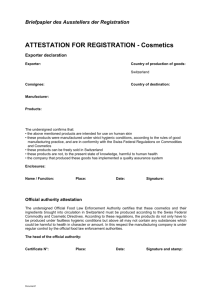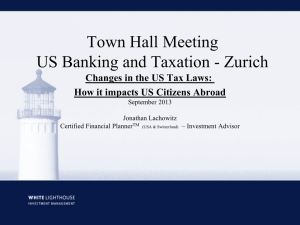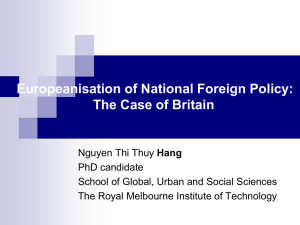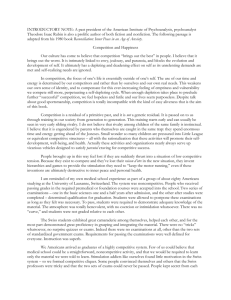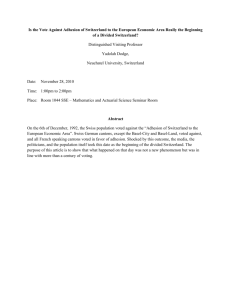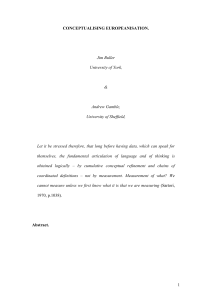The Europeanisation of Swiss Decision-Making in
advertisement
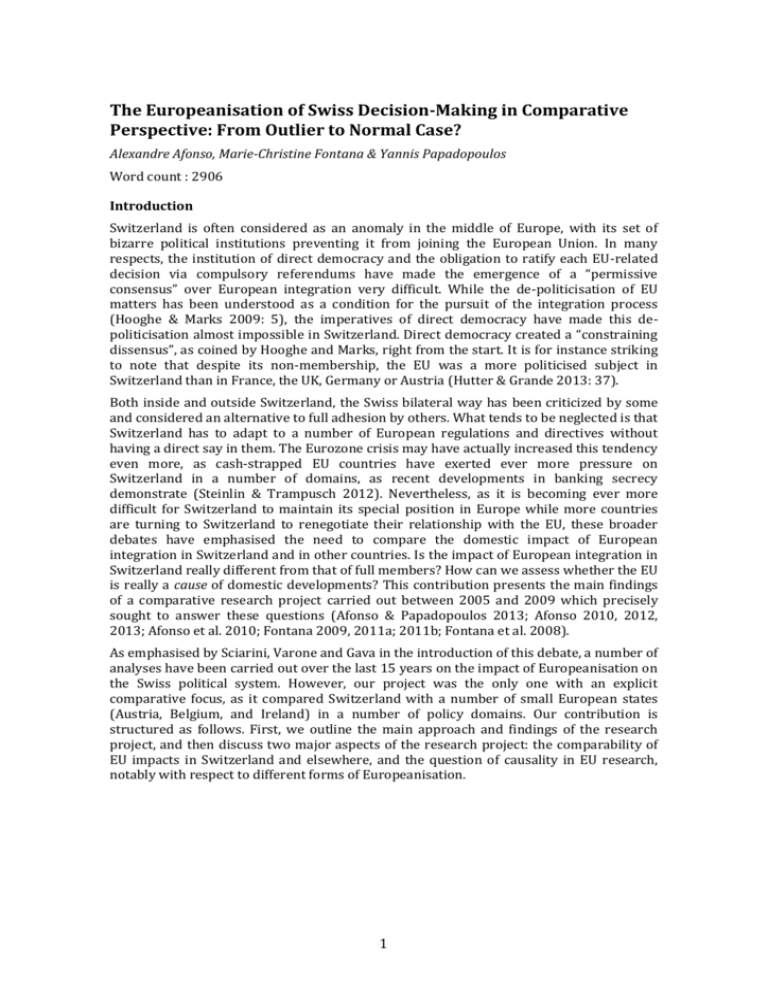
The Europeanisation of Swiss Decision-Making in Comparative Perspective: From Outlier to Normal Case? Alexandre Afonso, Marie-Christine Fontana & Yannis Papadopoulos Word count : 2906 Introduction Switzerland is often considered as an anomaly in the middle of Europe, with its set of bizarre political institutions preventing it from joining the European Union. In many respects, the institution of direct democracy and the obligation to ratify each EU-related decision via compulsory referendums have made the emergence of a “permissive consensus” over European integration very difficult. While the de-politicisation of EU matters has been understood as a condition for the pursuit of the integration process (Hooghe & Marks 2009: 5), the imperatives of direct democracy have made this depoliticisation almost impossible in Switzerland. Direct democracy created a “constraining dissensus”, as coined by Hooghe and Marks, right from the start. It is for instance striking to note that despite its non-membership, the EU was a more politicised subject in Switzerland than in France, the UK, Germany or Austria (Hutter & Grande 2013: 37). Both inside and outside Switzerland, the Swiss bilateral way has been criticized by some and considered an alternative to full adhesion by others. What tends to be neglected is that Switzerland has to adapt to a number of European regulations and directives without having a direct say in them. The Eurozone crisis may have actually increased this tendency even more, as cash-strapped EU countries have exerted ever more pressure on Switzerland in a number of domains, as recent developments in banking secrecy demonstrate (Steinlin & Trampusch 2012). Nevertheless, as it is becoming ever more difficult for Switzerland to maintain its special position in Europe while more countries are turning to Switzerland to renegotiate their relationship with the EU, these broader debates have emphasised the need to compare the domestic impact of European integration in Switzerland and in other countries. Is the impact of European integration in Switzerland really different from that of full members? How can we assess whether the EU is really a cause of domestic developments? This contribution presents the main findings of a comparative research project carried out between 2005 and 2009 which precisely sought to answer these questions (Afonso & Papadopoulos 2013; Afonso 2010, 2012, 2013; Afonso et al. 2010; Fontana 2009, 2011a; 2011b; Fontana et al. 2008). As emphasised by Sciarini, Varone and Gava in the introduction of this debate, a number of analyses have been carried out over the last 15 years on the impact of Europeanisation on the Swiss political system. However, our project was the only one with an explicit comparative focus, as it compared Switzerland with a number of small European states (Austria, Belgium, and Ireland) in a number of policy domains. Our contribution is structured as follows. First, we outline the main approach and findings of the research project, and then discuss two major aspects of the research project: the comparability of EU impacts in Switzerland and elsewhere, and the question of causality in EU research, notably with respect to different forms of Europeanisation. 1 Assessing Europeanisation Effects in a Comparative Perspective The main objective of the project “The impact of internationalization on Swiss policy processes in comparative perspective”1 was to assess the impact of European integration on patterns of decision-making in small European states, and more precisely on the patterns of cooperation between governments and organized interests (social concertation) in the decision-making process. In many respects, the literature provided ambiguous expectations as to this impact. On the one hand, following Katzenstein’s (1984, 1985, 2003) classic analysis of internationalization in small European states, Europeanisation was expected to strengthen incentives for governments to involve organized interests, and particularly trade unions and employers, in policymaking. This could happen through various causal mechanisms. First, as shown by the increase in social pacts some observers witnessed in the 1990s (Fajertag & Pochet 2000; Hancke & Rhodes 2005), European integration has been understood as a strong force for domestic concertation because of the economic constraints it imposes on governments. Second, as argued by Schmidt (2006), the “semi-pluralist” interest intermediation process that prevails at EU level tends to spill over at the domestic level, as shown by research conducted in the area of social policy (Falkner & Leiber 2004). On the other hand, following Moravcik’s (1994) or Milwards’s (1999) hypotheses, the EU has been believed to strengthen domestic governments who take directly part in international negotiations at the expense of other domestic actors. In this perspective, European integration should weaken concertation with organized interests and favour unilateral government action instead. In many ways, the project drew on previous work on the Swiss case (Fischer 2005; Fischer et al. 2002; Sciarini et al. 2004; Häusermann et al. 2004a, b; Mach et al. 2003). It sought to assess whether the findings of previous research were still valid for Switzerland, and whether the mechanisms of adaptation were similar in other countries. The methodology used in the research project was comparative both across countries and policy sectors (Haverland 2006). In order to assess whether the EU had a causal impact on patterns of decision-making we not only compared Switzerland with other EU countries, but also compared policy sectors with different degrees of Europeanisation within countries, namely the regulation of the free movement of workers, electricity liberalisation, competition law reform (strongly Europeanised), occupational pensions, and unemployment protection policy (weakly Europeanised). Concretely, the empirical analysis sought to test whether there was systematic variation in patterns of involvement of organized interests between strongly- and weakly-Europeanised policy sectors. Following Haverland (2006), we drew on the assumption that the causal impact of the EU can best be assessed by comparing sectors where the “EU factor” is both absent and present. In the following sections, we outline the main results of the research project structured around two dimensions: first, the differences and similarities between Europeanisation impacts in Switzerland and in similar countries, and second, the question of causality with respect to different types of Europeanisation (direct or indirect). Are Europeanisation effects different in Switzerland? What are the effects on Europeanisation in Switzerland? And are they different from effects in similar member states? Previous research on the impact of Europe on policymaking processes in Switzerland has yielded somewhat ambiguous results. While Mach et al. (2003) found that Europeanisation in the area of regulatory reforms allowed http://www.nccr-democracy.uzh.ch/research/research-phase-1/module2/ip4/ip-4-the-impactof-internationalization-on-swiss-policy-processes-in-comparative-perspective 1 2 for less inclusive patterns of policymaking, Sciarini et al. (2004) found fairly extensive patterns of participation of organized interests, particularly in the domain of the free movement of workers. In many ways, the results of the project tend to confirm this nonsystematic trend, both for Switzerland and European member-states: while Fontana (2011a; 2011b) found less inclusive patterns of policymaking in electricity liberalization and competition law reforms in Belgium and Switzerland, Afonso (2013) and Afonso and Papadopoulos (2013) found both inclusive (in Switzerland and Ireland) and exclusive (in Austria) decision-making processes in the domain of free movement of workers. Hence, none of the main hypotheses on the impact of Europeanisation on concertation – either in the direction of a strengthening or of a weakening – applied consistently across cases and countries, showing that the impact of Europeanisation is ultimately mediated by domestic factors. In general, both in Switzerland and elsewhere, domestic factors such as party coalitions and actor strategies appear as major mediating factors. Europeanisation per se, as will be argued in the next section, cannot be considered a sufficient cause for one or the other outcome. In spite of its non-membership and peculiar political institutions, however, many features observed in Swiss decision-making processes could also be observed elsewhere if one thinks in terms of functional equivalents (Fontana et al. 2008). The regulation of the free movement of workers, probably the most prominent aspect of the bilateral relationships between Switzerland and the EU, is a case in point. Indeed, the pattern of labour market opening and re-regulation observed in Switzerland through the so-called “flanking measures” negotiated between trade unions and employers could also be observed in Ireland, a country where “social partnership” has played a prominent role until the economic crisis that broke out in 2008 (Afonso 2012). In Switzerland, an extensive concertation procedure was put in place in order to buy the support of trade unions for the liberalization of labour migration policy (Afonso 2013: 132-153; Fischer et al. 2002). In this context, Swiss trade unions could use their veto power to trigger a concertation procedure and push for further regulation of the labour market as a side-payment. In Ireland, trade unions similarly used their veto power as negotiating partners in social partnership agreements to seek similar regulation measures designed to protect Irish wages in the context of labour mobility. After the Irish labour market was opened for workers of new EU countries in 2004, trade unions threatened not to negotiate a new social partnership agreement on wage increases that was considered important for employers. Similar to Switzerland, both employers and governments were forced to provide guarantees to trade unions in terms of protections against wage dumping, even if the actual regulatory reach of the agreement in Ireland was substantially weaker. While the regulation of free movement of workers both in Switzerland and Ireland shows inclusive patterns of policymaking, electricity liberalization in Switzerland and Belgium demonstrates how a European regulation can be used to exclude some actors, namely the unions, from policymaking. In both countries, a pro-liberalization coalition of the government, right-wing parties, and business associations negotiated a reform, while more skeptical left-wing parties and in particular unions were only marginally involved. This exclusive process was facilitated in both countries by the fact that the pro-European unions did not oppose the reform fundamentally, they only asked for more re-regulation of the electricity sector. Thus, they could not credibly threaten to block the reform, despite the veto points displayed by the two political systems.2 However, the Swiss electricity liberalization reform was finally rejected. The unions changed their position and opposed the reform fundamentally by launching an eventually successful referendum. 2 3 These cases show how Europeanisation can vary across sectors and countries, depending on prevailing domestic power relationships, cleavages and veto powers, but not so much on EU membership (Afonso 2010, Afonso et al. 2010, Fontana 2011). The limited explanatory power of Swiss non-membership and the importance of different cleavage patterns to determine patterns of inclusion and exclusion are particularly well illustrated in the following two cases (Afonso 2010, Afonso et al. 2010): When right-parties are united, inclusion patterns tend to be weak because right-wing majorities do not need trade unions and social democrats to build parliamentary majorities. This was the case in the weakly Europeanised reform of the unemployment insurance in Switzerland. When right-wing parties are divided between a pro-bilateral coalition (FDP and CVP) and a Eurosceptic wing (a majority of the SVP), however, inclusion patterns tend to be greater because pro-bilateral right-wing parties need trade unions and social democrats to build parliamentary majorities. This could be observed in the case of the strongly Europeanised regulation of free movement of workers. Thus, in this case, it was the specific pattern of party fragmentation in Switzerland combined with its importance rather than its nonmembership or the “direct” nature of Europeanisation per se that influenced decisionmaking patterns. Is the EU really a cause of domestic developments? A prominent question of earlier research on the Europeanisation of Swiss decision-making was the differential impact of “direct” and “indirect” forms of Europeanisation. Sciarini et al. (2004), for instance, compared cases that derived directly from bilateral negotiations between the EU and Switzerland (such as the free movement of workers already mentioned) and others where Switzerland adapted autonomously (such as the liberalization of telecommunications). Our comparative project compared not only direct and indirect Europeanisation in Switzerland, and thus in different policy sectors. We also compared direct and indirect Europeanisation in the same policy sector across countries, such as electricity liberalization in Belgium (direct) and Switzerland (indirect Europeanisation). This approach made it possible to investigate whether patterns of decision-making in regulatory policy are less inclusive because of the “indirect” nature of Europeanisation, or because of the specific features of this policy field. In many ways, comparative evidence points to the latter, as relatively similar features could be observed in similar policy fields across countries. As similar policy sectors tend to be populated by similar interests and actors across different countries, there may be quite consistent patterns of policymaking within policy fields, which may also be reinforced by diffusion effects. Finally, an important possibly hidden factor which may override Europeanisation is politicization. The comparative empirical analysis has shown that decision-making processes tend to be more inclusive when issues are politically very salient. This does not necessarily happen automatically, but after political actors manage to politicize issues in a way that can be damageable for the electoral or referendum prospects of the government. For instance, a working group on the strengthening of the flanking measures to the free movement of workers was established only after trade unions made clear that they were ready to support a referendum against free movement if guarantees for the protection of Swiss wages were not provided. The government, by contrast, was ready to extend the free movement of workers to new countries without necessarily strengthening labour market protection. Along similar lines, in Ireland, re-regulation measures were introduced after a vivid political campaign whereby trade unions strived to place the issue of job displacement on the agenda. A media analysis showed that the government triggered a concertation process after media attention to this issue peaked. In many ways, this was a 4 proof that politicization only impacts on decision-making processes insofar as it is used by political actors, be it in Switzerland or abroad. References Afonso, A. (2010) "Europeanisation, Policy Concertation and New Political Cleavages: The Case of Switzerland", European Journal of Industrial Relations 16(1): 57-72. ——— (2012) "Employer Strategies, Cross-Class Coalitions and the Free Movement of Labour in the Enlarged European Union", Socio-Economic Review 10(4): 705-730. ——— (2013) Social Concertation in Times of Austerity. European Integration and the Politics of Labour Market Reforms in Austria and Switzerland. Amsterdam: Amsterdam University Press. Afonso, A., M. Fontana, and I. Papadopoulos (2010) "Does Europeanisation Weaken the Left? Changing Coalitions and Veto Power in Swiss Decision-Making Processes", Policy and Politics 38(4): 565-582. Afonso, A., and Y. Papadopoulos (2013) "Europeanization Or Party Politics? Explaining Government Choice for Corporatist Concertation", Governance 26(1): 5-29. Fajertag, G., and P. Pochet (2000) Social Pacts in Europe: New Dynamics. Brussels: European Trade Union Institute. Falkner, G., and S. Leiber (2004) "Europeanization of Social Partnership in Smaller European Democracies?", European Journal of Industrial Relations 10(3): 245. Fischer, A. (2005) Die Auswirkungen Der Internationalisierung Und Europäisierung Auf Schweizer Entscheidungsprozesse. Zürich: Rüegger. Fischer, A., S. Nicolet, and P. Sciarini (2002) "Europeanisation of Non-Eu Countries: The Case of Swiss Immigration Policy Towards the Eu", West European Politics 25(4): 143-170. Fontana, M.-C. (2009) "Transnationalization and Domestic Policy-Making Processes: Electricity Market Reform in Belgium and Switzerland" (ed.) The Transnationalization of Economies, States, and Civil Societies. Springer: 157-178. ——— (2011a) "Europeanization and Domestic Policy Concertation: How Actors Use Europe to Modify Domestic Patterns of Policy-Making", Journal of European Public Policy 18(5): 654-671. ------- (2011b) "Europeanisation and domestic concertation. Comparing policy sectors in Belgium and Switzerland. Thèse, Uni Lausanne. (ou: forthcoming "…" (working titel). Nomos. Fontana, M., A. Afonso, and I. Papadopoulos (2008) "Putting the Special Case in Its Place: Switzerland and Small-N Comparison in Policy Research", Swiss Political Science Review 14(3): 521-550. Hancke, B., and M. Rhodes (2005) "Emu and Labor Market Institutions in Europe: The Rise and Fall of National Social Pacts", Work and Occupations 32(2): 196. Häusermann, S., A. Mach, and I. Papadopoulos. (2004a) "Explaining Policy Transfer Mechanisms in Small European Countries: The Case of Telecommunication Reform." in Levi-Faur, D., and E. Vigoda-Gadot (eds.) International Public Policy and Management: Policy Learning Beyond Regional, Cultural, and Political Boundaries. New York: Marcel Dekker: 121-154. Häusermann, S., A. Mach, and I. Papadopoulos (2004b) "From Corporatism to Partisan Politics: Social Policy Making Under Strain in Switzerland", Swiss Political Science Review 10(2): 33-59. Haverland, M. (2006) "Does the Eu Cause Domestic Developments? Improving Case Selection in Europeanisation Research", West European Politics 29(1): 134 - 146. 5 Hooghe, L., and G. Marks (2009) "A Postfunctionalist Theory of European Integration: From Permissive Consensus to Constraining Dissensus", British Journal of Political Science 39(01): 1-23. Hutter, S., and E. Grande (2013) "Politicizing Europe in the National Electoral Arena: Is the Giant Still Asleep?", Paper prepared for the 20th Conference of Europeanists, June 24-28 2013, Amsterdam Katzenstein, P.J. (1984) Corporatism and Change : Austria, Switzerland, and the Politics of Industry. Ithaca ; London: Cornell University Press. ———. (1985) "Small Nations in an Open International Economy: The Converging Balance of State and Society in Switzerland and Austria" in Evans, P., D. Rueschemeyer, and T. Skocpol (eds.) Bringing the State. Cambridge: Cambridge University Press: 227-256. ——— (2003) "Small States and Small States Revisited", New Political Economy 8(1): 9-30. Mach, A., S. Häusermann, and Y. Papadopoulos (2003) "Economic Regulatory Reforms in Switzerland: Adjustment Without European Integration, Or How Rigidities Become Flexible", Journal of European Public Policy 10(2): 301-318. Milward, A. (1999) The European Rescue of the Nation State. London: Routledge. Moravcsik, A. (1994) "Why the European Community Strengthens the State: Domestic Politics and International Cooperation", CES Working papers 52): Schmidt, V. (2006) "Procedural Democracy in the Eu: The Europeanization of National and Sectoral Policy-Making Processes", Journal of European Public Policy 13(5): 670-691. Sciarini, P., A. Fischer, and S. Nicolet (2004) "How Europe Hits Home: Evidence From the Swiss Case", Journal of European Public Policy 11(3): 353-378. Steinlin, S., and C. Trampusch (2012) "Institutional Shrinkage: The Deviant Case of Swiss Banking Secrecy", Regulation & Governance 6(2): 242-259. Words: 3'060 6
